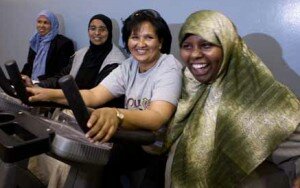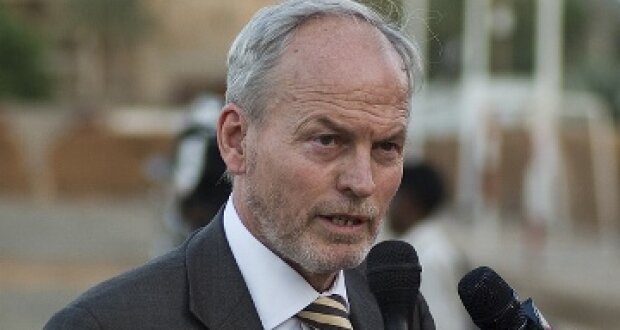 By Alexandra Zabjek, Edmonton Journal — Ignore the potholed parking lot, faded bricks and grated windows, the empty corridor with the broken clock, and look only at the young faces in this classroom, where a homework club unlike most others is taking place, where the multicultural future of a prairie city is taking shape.
By Alexandra Zabjek, Edmonton Journal — Ignore the potholed parking lot, faded bricks and grated windows, the empty corridor with the broken clock, and look only at the young faces in this classroom, where a homework club unlike most others is taking place, where the multicultural future of a prairie city is taking shape.
A girl in a hijab as bright as her smile plays a game with friends, volunteers quizzing them on math questions as they move pieces around a board. Around her, children who have made the journey from Africa to Edmonton focus on puzzles, and computers, and games, their chatter infusing the old Wellington Junior High School with new life.
Look down this hallway. Young boys in stockinged feet kneel to face Mecca, touching their foreheads to a red prayer rug.
Turn around. Basketballs thump on a hard gym floor. Impossibly long bodies leap into the air.
Open this door. Beans, peppers, and tomatoes grow in a makeshift greenhouse, tended to by immigrants who come from countries where they never knew sub-zero temperatures.
This is the Africa Centre, part community organization, part cultural hub, part leap of faith for a group of community leaders who want to unite a diverse immigrant population that is growing each year. The children who attend the homework club, like the adults who promote it, come from across a continent that stretches from the Mediterranean Sea to the Indian Ocean.
In the year since it has opened, the centre has organized homework clubs and summer camps for children while garnering attention from officials such as Mayor Stephen Mandel, an enthusiastic backer of the organization. The city has donated space at the junior high school, while the downtown Rotary Club offered a $350,000 legacy grant for early childhood education programs and a communal kitchen project.
Those are tremendous feats for any fledgling organization, but consider this: There are more than 50 countries in Africa. Co-operation doesn’t always come easily. Some say there are too many religions, too many languages, too many differences.
“When we talk about Africa, we’re talking about a complexity that’s far different than people coming from other homogeneous areas. You’ve got people coming from literally a pre-modern world, and you have graduate students,” says Dawit Isaac, an Eritrean-born, Ethiopian-raised pastor who now sits on the Africa Centre’s board of directors.
At best, someone from northern Africa might have little in common with someone from the southern tip of the continent. At worst, wars have been waged across tribal and religious lines.
But in Edmonton, African community leaders have long been told that if they want political support and funding, they must work together. Funders can do little for 1,000 Ugandans, 2,000 Somalis or 3,000 Kenyans. But a group of 6,000 Africans? That’s another story.
Federal statistics tell yet another story. Between 1998 and 2007, the number of African immigrants and refugees arriving in Alberta almost tripled. They come from countries such as Muslim-dominated Somalia and Christian-dominated Zimbabwe. But in Edmonton, they are often seen by others as a single group, simply as Africans.
Hafsa Goma came to Canada in 1987 from Uganda, via Egypt. The African community in Edmonton was so small at the time that meeting another member of the diaspora on the street would sometimes lead to an impromptu dinner invitation. Many Africans were graduate students at the University of Alberta.
In the years since, more Africans in the city have come from wartorn lands as refugees.
Goma remembers an incident a few years ago when an African teenager, armed with knife, robbed a store on 107th Avenue.
She thought it was time for an organization that would join all African communities together to support their young people.
If the African community’s demographics have changed, so has its mindset, says Goma. More Africans are starting to think of Edmonton as home and not just a stop before moving on to somewhere else.
“I think people have realized we’re here to stay; we’re not just here to study and then go home,” says Goma, who sits on the centre’s board. “This is home, and it took a while for us to realize that.”
For those who stay, life in Edmonton is sometimes frightening.
“Back home, everyone knows each other, you let the kids play outside. If the kids do something wrong, everyone can discipline them. They’ll say, ‘I’ll tell your dad,’ ” says Abukar Nur, a program co-ordinator for the Somali community at the Africa Centre.
“Here, you’re scared. Everything is unknown to you.”
There is perhaps irony in the idea that people from lands wracked by civil war can find Edmonton’s elm-lined streets intimidating. But irony doesn’t trump experience.
A centre where Muslims can pray without anyone taking notice and where large families can let their children play is vital for community growth, says Nur, who oversees basketball games and homework clubs on Tuesday and Thursday nights at the centre. On weekends, there are Somali language classes. Other African groups use the centre in similar ways, although the Somali presence appears to be the largest. Each group pays a nominal fee to rent space for its functions, and occasionally there are cross-community events, such as soccer tournaments and festivals.
At the head of all this is Tesfaye Ayalew.
The Ethiopian immigrant grapples with issues such as:How can the centre help a refugee family from Sudan lift itself from poverty?How can the scientist from Nigeria be connected with employers in his field?How do you help a mother from Sierra Leone navigate the school system?
Ayalew, the organization’s executive director, insists, however, that before the community can find its way in the city as a whole, it must first find peace within itself.
It hasn’t always been easy. A few months ago, Ayalew was approached by two groups from Sudan, a country that for years has been split along north-south, Muslim-Christian, Arab-African lines. The groups faced a conundrum particular to Edmonton: They both wanted booths at the Heritage Festival.
Event organizers, however, only permit one per country.
Through a series of discussions, Ayalew and Heritage Festival organizers helped organize a settlement. Now, Sudan will be featured at this year’s festival under one tent.
Then there was the Black History Month celebration, where a group of teenage girls performed an exuberant, rump-shaking dance typical of some African regions.
Not everyone at the centre was pleased. A woman in a conservative hijab looked disapprovingly while the teens swivelled their hips in front of a packed gym. The woman later approached Ayalew and asked why such a performance was permitted at the event.
Ayalew chuckles when he recounts the story. “I told her, ‘This is Africa!’ “
Ayalew came to Canada in 1988 as a graduate student in biology and animal sciences. He hasn’t returned to Ethiopia since. But like many immigrants, he often thinks of the land he came from and what his connection to it should now be.
On a recent Saturday afternoon, Ayalew walked into an office at the Africa Centre and distributed cups of coffee to a group of Zimbabweans gathered there. Outside, it’s an unusually warm day in Edmonton. Inside, talk turns to Africa.
“China has already invested billions in Ethiopia for telecommunications, and India has just become the country’s biggest investor,” says Ayalew. “Why is the West not there?”
“I like the idea of foreign investors. We want it, but how do we manage to make it meaningful for Africans?” asks Tendai Moyana.
For Ayalew, the case for Canadian business involvement in Africa has never been more compelling. Educated African immigrants could help Canadian businesses unfamiliar with the continent set up shop there. It would be a win for immigrants in Edmonton, a win for businesses and a win for Africans who would benefit from the investment, argues Ayalew. The Africa Centre could bring the groups together.
It’s that kind of thinking that propelled one of the centre’s first major projects last year, a summer camp for children. When the idea was first bandied about, the centre planned to host 40 students for a few hours each day. Within two weeks, they had a six-week camp organized for almost 100 children from a half-dozen African countries.
“There was such a will,” says Liz O’Neill, executive director of Big Brothers Big Sisters Edmonton, an organization that has partnered frequently with the centre and helped organize the summer camp.
Increasingly, says O’Neill, Big Brothers Big Sisters is working with children from immigrant communities. She thinks organizations such as the Africa Centre will change the way social services are delivered. Big Brothers Big Sisters has resources and experience, but it doesn’t necessarily understand the intricate needs of immigrant communities. “Hybrids” of old and new service agencies need to form.
“We’ve built services for the Edmonton that we’ve known for the past 25 years. That Edmonton is changing,” she says. “There are new populations that have different needs and wants. The Africa Centre knows what it needs, but it doesn’t have those connections.”
The idea that this kind of community group represents an important piece of Edmonton’s future is not lost on Mayor Stephen Mandel.
The city needs immigrants to be successful, he says. He stands behind the support given the organization, despite grumblings from some that the Africa Centre has received special treatment.
He points to the city’s Chinese community, which has existed in Edmonton for almost 100 years and has business and political clout.
“African communities are not like that. They’re recent immigrants to our community and we need to reach a little more to that group than to some other ones. That’s just the circumstances today,” he says.
“It’s a great project and hopefully we’ll be able to expand the services we give to our emerging communities.”
At the Africa Centre, people such as Muru Khamisi believe the African community’s biggest advantages can be found within.
Khamisi was a pilot in Uganda in the 1970s before making the journey to Canada via Sudan and Ethiopia. On a whim, he pulls out his pilot’s identification card for Uganda Airlines. In the photograph, he is a young man, with a smooth face and an air of confidence. The card is withered after almost 40 years tucked in a wallet.
“We have all the capacities–doctors, lawyers, engineers. And if you need a pilot, he’s there. Old and ragged, but he’s there,” he says.
“To me, this is like a village where everyone will take care of the kids, no matter where they’re from. The best of this place hasn’t even started.”






